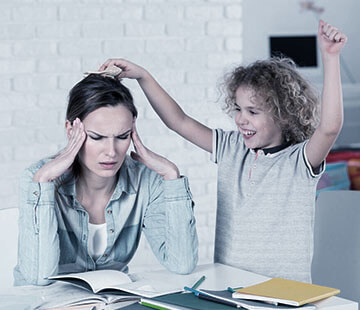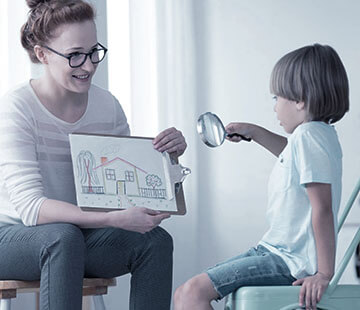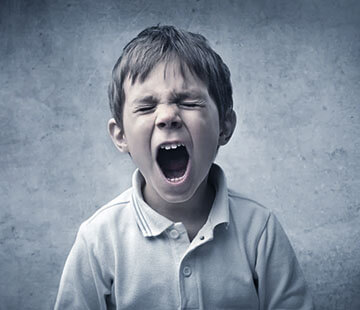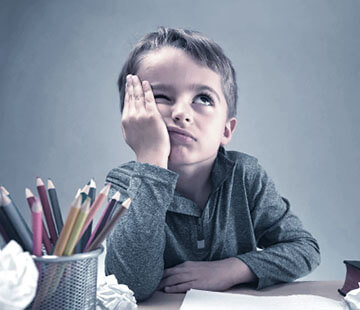Introduction
A seven-year-old kid came in first grade. A month ago he was considered a kindergarten teacher, he was allowed to run, jump, represent himself as a pilot or driver, he could move every five minutes from one part of the yard to another ... And then he was honored to be called "first grader" and put behind the desk. How difficult it is for him, a tomboy, to immediately rebuild, to sit out the cherished forty minutes. The kids try, try to follow the teacher, remember, answer, sit still. But almost every class has a child who finds it hardest to switch to such a serious activity. Such a pupil will be constantly distracted by himself and others, pulling neighboring girls by braids, writing notes and trying to pass them on, he no longer follows the lesson and can not answer if asked.
Children are all different, but what should the teacher do if the child is not just active, but is pathologically active? How do we catch the difference between the norm and the disease of "hyperactivity"? Matthew Smith, a postgraduate student at the Centre for Medical History at the University of Exeter, Edmond, UK, believes that the problem of modern children's hyperactivity as a pathological condition has recently intensified. But many parents, teachers and children themselves have a misunderstanding of the phenomenon as such.
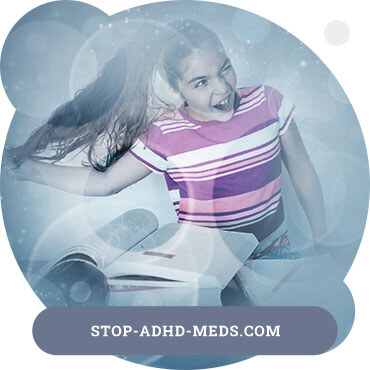
In my work I want to understand this problem - what is Attention Deficit and Hyperactivity Disorder, how it manifests itself, and whether it is really so widespread. I also want to consider what problems the child and the teacher working with him/her have in the pedagogical process, what are the ways to solve them. And, of course, what assistance can be provided to the child by the specificity of the school's fine arts subject in correcting the public and personal problems of such children.
Attention - ADHD!
Hyperactive guys... These kids are also called "indigo kids," they say they have a bright blue aura. Some believe that they have the future of humanity, others refer to them as "difficult" and "untenable." In order to find out who they are, one must first turn to the very definition of "hyperactivity".
Hyperactivity - overactivity - "hyperdynamic syndrome" as a manifestation of violations of the system of emotional regulation. It is associated with microorganic brain lesions resulting from many causes (complications of pregnancy and childbirth, somatic diseases in early childhood, mental and physical trauma, etc.).
This syndrome is quite rare in the population. This is evidenced by studies conducted in the USA, UK, Germany, Czechoslovakia, China and other countries. The analysis of the literature has revealed a wide variability of data on the syndrome prevalence: in the USA these figures fluctuate from 4 to 20%, in Great Britain - 1-3%, Germany - 9-18%, Italy - 3-10%, Czechoslovakia - 2-12%, China - 1-13%, Austria - 7-10%.
Such a wide range - from 1 to 20% - is primarily due to the lack of common diagnostic criteria and methods for assessing symptoms of the disease. American and Canadian specialists use the "Diagnostic and Statistical Manual of Mental Diseases", which is periodically published by the American Psychiatric Association. The United Kingdom and European countries, including our own, have adopted an "International Classification of Diseases" with strict criteria that allow a more realistic assessment of the prevalence of this disease.
In Russia, according to a study published in the Neurological Journal (No. 6, 1998) by N.N. Zavadenko, A.S. Petrukhina, N.G. Manelis, and others, of the 537 children surveyed in Moscow schools, 7% had ADHD, which is one of the factors in the development of school de-adaptation.
It should be clearly understood that ADHD is a psychiatric diagnosis; it is the responsibility of a psychiatrist only and has a clear clinical picture, and it is not legitimate to talk about it in relation to children under 5-6 years old. If a child is supposed to be hyperactive, he or she must be observed by a psychiatrist for at least six months, undergo a large number of different tests, and if he or she has not "passed" at least one criterion, it means that he or she is just a very active child, but not more.
The number of this diagnosis in Russia is also affected by the fact that he began to be exhibited by neurologists, confusing him with HYPERVOUSE (this applies to the nervous system, and hyperactivity - to the psyche). During my research, I came across the fact that Attention Deficit Hyperactivity Disorder is given to children under 3 or even 1 year of life. What attention deficit can we talk about when the child is only a couple of months old? And with such a diagnostic card, the child will then go to school, where he will already be biased because of the wrong diagnosis.
Problem: ADHD children and school
So, what are the manifestations of this disease.
Attention Deficit Hyperactivity Disorder (ADHD) is a certain picture of a child's physical and psychological development in which he or she has attention deficit, impulsivity, increased motor activity and excitability. Such a child strives to be in time for everything at once, but this haste is unproductive, not having had time to get acquainted with one subject or activity, the child is already interested in another thing or kind of activity, dropping the initiated cases.
The onset of symptoms refers to the beginning of kindergarten (3 years), and the first deterioration refers to the beginning of school. This pattern is explained by the inability of the central nervous system of a child suffering from the disease to cope with the new requirements of increased mental and physical stress. The maximum severity of the syndrome coincides with the critical periods of formation of the central nervous system in children. 3 years - the beginning of active development of attention, memory and speech. Forced increase of loads at this age may lead not only to behavioral disorders in the form of stubbornness and disobedience, but also to lagging behind in neuro-psychiatric development. The age of 6-7 years - a critical period not only for the formation of written speech, but also arbitrary attention, memory, targeted behavior and other functions of higher nervous activity.
Therefore, if at preschool age among children with Attention Deficit Hyperactivity Disorder, hyper-excitability, motor retardation, motor awkwardness, distraction, increased fatigue, infantilism, impulsivity are prevalent, schoolchildren's difficulties in learning and behavioral deviations are in the foreground. In adolescence, symptoms of the disease may cause the development of asocial behavior: delinquency, alcoholism, drug addiction. Inadequate behavior, social misadaptation, various personality disorders can also cause failure in adulthood. In this regard, the efforts of specialists should be aimed at timely detection and correction of this disease. Early therapy in childhood will not only help to overcome the lag in the neuro-psychiatric development of the child, but will contribute to the formation of normal behavior in adulthood.
The main symptom, according to the new name, is a sign of "attention disorder": a child can not concentrate more or less time on any activity, his attention jumps from one subject to another. These children often drop out of a class without achieving a result.
It should be noted that attention impairment in this disease is found in 100% of cases, and motor retardation - quite often, but not always. When they say "attention deficit", this is understood as an inability to concentrate attention for a short period of time. Not only is the child unable to complete the task, but he or she is also careless, particularly with regard to school tasks. In the lesson, he can not work together with the whole class, it is difficult for him to remember the instructions of the teacher. This behavior is usually less noticeable in one-on-one situations or in normal surroundings.
Parents will usually learn about their child's lack of attention at the beginning of the first year. Often the teacher is the only one who informs them about this. In class, these children are constantly distracted by ambient sounds or visual disturbances that other pupils do not notice. Distractibility may be related to their own bodies, clothing, and other objects.
Since attention is one of the most important mental functions that ensure the success of learning, at the end of the first half of the year, hyperactive children are already markedly behind other children in learning. Their increased activity, inability to concentrate on anything, as well as perception disorders, lack of speech development create the basis for learning difficulties. Although psychologists note that they have an average or even higher average intelligence coefficient.
Specialists say they have memory problems, reduced mental performance, increased fatigue. These abnormalities are manifested primarily in the classes at school. The child in class is often distracted, unable to complete the task, makes many mistakes, but not because of misunderstanding, but because of inattention. The distraction increases as the duration of the task increases, which indicates increased fatigue of the nervous system. The productivity of such children in class is very low. The main characteristics of attention: concentration, switching, stability, distribution, volume - they are below normal. The amount of RAM and thinking is reduced, the child can keep in mind and operate with a limited amount of information, most of which is soon forgotten. Long-term memory is weak because temporary connections are difficult to form. A characteristic feature of the mental activity of children with the syndrome is cyclicality. The time during which they can work productively, does not exceed 5-15 minutes, after which they lose control over mental activity. Some time (3-7 minutes) the brain "rests", accumulating energy and strength for the next work cycle. At the moments of "shutdown" the child is doing other things, and the teacher does not react to the words. Then mental activity recovers, and the child can again work productively for 5-15 minutes, after which the brain again "shuts down" and arbitrary control of intellectual activity is impossible.
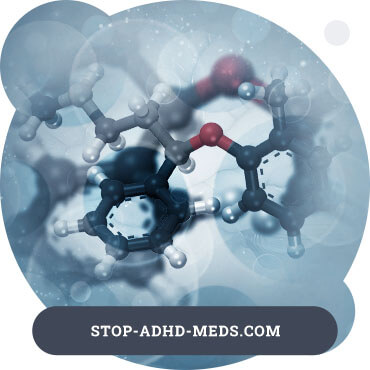
Such features of intellectual activity in combination with perception, speech and hand coordination disorders contribute to the difficulties of children with reading, writing and counting syndrome. This is by no means connected with an intellectual defect. Having good intellectual abilities, hyperactive children are characterized by reduced interest in intellectual activities, art and fine arts. Certain deviations in the motivational sphere, which is manifested by frequent refusals to do something, lead them to a lack of interest in systematic, demanding attention classes, and thus - to learning activities.
With the existing organization of the educational process in schools, the burden on healthy schoolchildren is excessive for children with such deviations.
Hyperactive children's activity is not targeted, insufficiently motivated and does not depend on the situation - they are always mobile, although by the end of the day due to general fatigue "superactivity" is expressed in hysteria, unjustified attacks of irritation, tearfulness.
Such a child is in a hurry and fuss all the time; he starts the task without hearing the instructions, and then repeatedly asks questions, makes mistakes, and fails to keep up with the teacher. In his notebook it is dirty, he throws the independent and control ones undone or, having quickly made them, gives them up with mistakes. It is difficult for him to organize himself, so in the classroom he requires a lot of attention from adults. Comments and reprimands in these cases do not help. The child is often not happy himself, but he can not cope, "run away" from himself. Shouting and reprimanding the teacher only aggravates the situation: the child is lost even more and finally falls behind the class. Now he not only can not, but also does not want to control his behavior.
It should be noted that in no other case do violations of behavior cause as many censures and complaints from parents, teachers and educators as in this case. A hyperactive child is most threatened by misunderstanding from others. He is constantly being chased, shamed, pulled and punished. In the end, the child is persuaded that he is incapable of anything and that he is the stupidest person in the world. As a result, the child is hardened. He develops a negative and often aggressive reaction to others, he becomes an uncontrollable, "difficult" child. Such model of protective behavior is sometimes beneficial for him, and therefore difficult to correct.
Emotional disorders are extremely important for understanding the nature of hyperactive behavior and for correcting its manifestations. First of all, it is excessive excitability and impulsivity caused by the deficit of deterrent control and self-regulation of behavior. The child shows increased emotional activity, which is expressed in increased chattiness. In class, this is a constant headache for the teacher. Children with the syndrome are characterized by frequent mood swings. They easily pass from tears to laughter, quickly forget their failures.
Correction methods for hyperactive children
Having looked at all the signs of this disease, it becomes clear why such children are difficult for our education system. It is very difficult for the teacher, with a total of 25-30 pupils in the class to adjust to one unsuitable child. But after all, psychologists point out that indigo children have an average IQ and above average, so they can well and fully absorb the school curriculum.
There are many articles on the Internet about difficulties in educating children in our schools. The Appendix contains a collection of "ADHD Children and the Russian School. Excerpts from discussions at the forum of parents of children with ADHD", which clearly shows the unpreparedness and obvious unwillingness of teachers to accept the special features of such children. However, there are various psychological and pedagogical methods of correction of attention deficit syndrome, among which behavioral psychotherapy plays a major role. There are psychological assistance centres abroad that provide special training in these methods for parents, teachers and child doctors.
The key aspect of the behavioural correction programme is to change the child's environment at school and at home in order to create favourable conditions for overcoming the lag in the development of mental functions.
The home correction program includes:
- change of the adult's behavior and attitude towards the child (demonstrate calm behavior, avoid the words "no" and "no", relationships with the child to build on trust and understanding); change of the psychological microclimate in the family (adults should quarrel less, spend more time with the child, spend leisure time with the whole family);
- the organization of the day and place for the class;
- a special behavioural programme with a predominance of support and reward methods.
The home programme has a behavioural aspect, while the school focuses on cognitive therapy to help children cope with learning difficulties.
The school's remedial programme includes:
- changing the environment (the place of the child in the classroom - next to the teacher, changing the mode of the lesson to include moments of active rest, regulating the relationship with classmates);
- creating positive motivation, situations of success;
- correction of negative forms of behavior, particularly unmotivated aggression;
- regulation of expectations (applies also to parents), as positive changes in a child's behavior do not manifest themselves as quickly as others would like.
Behavioural programs require considerable skill, adults have to apply all their imagination and experience of communication with children in order to maintain the motivation of a constantly distracted child during the lessons.
Corrective methods will only be effective if there is close cooperation between the family and the school, which should necessarily include the exchange of information between parents and teachers through joint seminars, training courses, etc. Success in treatment will be guaranteed if uniform principles regarding the treatment of children at home and at school are maintained: a system of "rewards", assistance and support for adults, participation in joint activities. Continuity of treatment therapy at school and at home is the main guarantee of success.
In addition to parents and teachers, doctors, psychologists, social workers - those who can provide professional help in individual work with such a child - should also be of great help in organizing the correction program.
Correction programs should be focused on the age of 5-8 years, when the compensatory possibilities of the brain are great and the pathological stereotype has not yet been formed.
It should be remembered that negative methods of upbringing are ineffective in these children. Features of their nervous system are such that the threshold of sensitivity to negative stimuli is very low, so they are not susceptible to reprimand and punishment, but easily respond to the slightest praise. Although the ways of rewarding and encouraging the child should be constantly changed.
The home rewards and recognition programme includes the following points:
- Every day, the child has a specific goal to achieve.
- The child's efforts to achieve this goal are encouraged in every way.
- At the end of the day, the child's behaviour is assessed according to the results achieved.
- Parents shall periodically inform the attending physician about the changes in the child's behaviour.
- If a significant improvement in the behaviour is achieved, the child receives the long promised reward.
Examples of the goals set for the child are: good homework, helping a weaker classmate to prepare lessons, good behavior, cleaning his room, preparing lunch, shopping and others.
When talking with your child, and especially when you are giving them assignments, avoid guidelines, turn the situation around so that the child feels that they will do a good job for the whole family, they are fully trusted and hoped for. When communicating with your son or daughter, avoid constant twitching like "sit still" or "don't talk when I'm talking to you" and other unpleasant things.
A few examples of rewards and rewards: allow your child to watch TV in the evening for half an hour longer than allowed, buy a special dessert, give the opportunity to participate in games with adults (lotto, chess), let the extra time to go to the disco, buy the thing he has long dreamed of.
If a child behaves approximately during the week, he should receive an extra reward at the end of the week. This could be some kind of trip with parents to the countryside, a trip to the zoo, the theatre and others.
This behavioral training is ideal and it is not always possible to use it at the present time. But parents and teachers can use individual elements of this program, taking its basic idea: encouraging your child to achieve their goals. It doesn't matter whether it is a material reward or just an encouraging smile, a kind word, increased attention to the child, physical contact (stroking).
If the behaviour is unsatisfactory, a light punishment is recommended, which should be immediate and inevitable. It can simply be verbal disapproval, temporary isolation from other children, deprivation of "privileges".
Parents are advised to write a list of what they expect from the child in terms of behaviour. This list can be explained to the child in an accessible manner. Everything written is then strictly adhered to and the child is encouraged to be successful in doing so. Physical punishment must be avoided.
It is believed that medication therapy combined with behavioural techniques is the most effective. After the treatment, one mother said: "I have never been as happy as a mother or proud of my son." Teachers also noted a significant improvement in behavior and learning. The teenager won several prizes at the school Olympiad and achieved success in the swimming section.
Articles
The importance of fine arts lessons for the harmonious development of a child with ADHD
The program of harmonious development of personality in our country requires the general education school to prepare the younger generation for life in such a way that it corresponds to the scientific and technological progress, the level of development of modern culture. As ADHD children study at general education schools (not correctional schools) together with healthy children, they also need to master the common educational standard. Let us first consider the goals of the general school fine arts course.
The standard school course of the fine arts, proceeding from the general problems of education, sets the purpose: to prepare comprehensively developed, educated members of the society, capable to take active part in various branches of the state, public and economic life of the country.
In order to achieve this goal it is necessary to solve the following tasks:
- To bring up children in an aesthetic way, to develop their artistic taste.
- To help children to know the world around them, to develop their observation, to train them to think logically, to realize what they have seen.
- To reveal the practical significance of drawing in human life, to teach to use it in work, in socially useful work.
- To give pupils the knowledge of elementary bases of realistic drawing. To instill skills and abilities in fine arts, to acquaint with the basic technical methods of work. To instill love for work, to bring up accuracy and perseverance in the work. Develop the creative abilities of students, give the right direction to their aesthetic perception of the world. Develop spatial thinking, imaginative representation and imagination.
- Familiarize students with outstanding works of Russian and world fine art. To instill interest and love for fine arts.
Teaching the fine arts at school should help children to know the surrounding reality, to see and understand the beautiful in human relations, to form the desire to care about the beauty of their land, home, their image. We should take care that there is no one-sided education. The child should learn to see the different sides of our reality, and there are all possibilities for that.
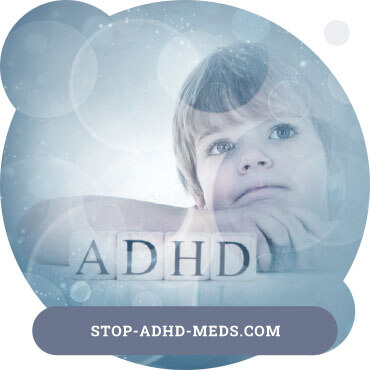
According to this, teaching methods should be based on various pedagogical and educational technologies. When preparing any fine arts lesson, not only the age of the children, but also their abilities should be taken into account.
One of the main tasks of art teaching is to develop in a child an interest in the inner world of a person, the ability to "deepen into themselves", awareness of their inner experiences. For this purpose, the artistic activity of schoolchildren in fine arts classes should find various forms of expression:
- image on the plane and in volume (from nature, by memory, by presentation)
- decorative and constructive work
- perception of reality and works of art
- discussion of comrades' work, the results of collective creativity and individual work in class
- artistic heritage research
- case study
- listening to musical and literary works (folk, classical, modern).
In addition to performing educational tasks, visual arts classes are an important tool for the comprehensive development of children, especially children with developmental disabilities. Drawing classes enable solving many tasks in a form interesting for the child. Teaching drawing, modeling, applications and design helps to mentally, morally, aesthetically and physically educate any schoolchild.
On the basis of the second chapter we will allocate the main problems of student's activity of ADHD-children, and then we will consistently understand, how the fine arts activity allows to solve them.
- Violation of attention and increased distractiveness do not allow the child to fully focus on the pedagogical process.
- Breaking the basic characteristics of memory and cycling in the work prevent the creation of temporary links, which leads to violations in long-term memory as well.
- Violations of hand coordination and fine motor skills of fingers in particular.
How can a hyperactive child be helped in drawing lessons?
Now almost every mommy knows that by school it is necessary to develop the child's fingers to make it easier to learn to write. But it has been proven that the development of fine motor skills is not only the development of muscle fingers, but also a very good development of the brain, its thinking activity, and memory. I think that this is the basic law of successful development of learning activity not only for healthy children, but also for hyperactive children in particular. For ADHD children, fine motor skills classes should be in large numbers as early as the preschool period and continue almost the entire time they are in school. Drawing lessons are a good solution to this problem. Application, modeling, design - the main development for motor skills fingers.
Fine art helps to solve many issues of education and training. From the side of education in hyperactive children have the same problems as in healthy children, so it is worth considering all the values of visual activity for personal development in general.
On the importance of drawing for mental development wrote MI Kalinin: "A person who has learned and used to draw, especially suitable for each new subject. He will think from different sides, draw such an object, and he will already have an image in his head. And this means that he will penetrate deeper into the very essence of the object.
To properly portray an object, you must have a clear idea of it, that is, to see the characteristics of the object, their relationship to each other, shape, color. As a result of targeted training, each child begins to highlight the main, essential in the depicted.
The development of visual and imaginative thinking takes place in the learning process. Researches of the teacher N.P. Sakulina have shown that successful mastering of techniques of the image and creation of an expressive image demand not only clear representations of separate subjects, but also establishment of communications of appearance of a subject with its appointment in a number of subjects or the phenomena. Therefore before the beginning of the image children solve mental problems on the basis of the concepts formed at them, and then search for ways of realization of this problem.
Visual activity is closely connected with the solution of moral education problems. This connection is carried out through the content of children's work, which fixes a certain attitude to the surrounding reality, and upbringing in hyperactive children of observation, perseverance, activity, independence, initiative, ability to listen and perform the task, to bring the started work to the end.
The surrounding life gives children rich impressions, which are then reflected in their drawings, applications, etc. In the process of image fixes the attitude to the depicted, as the child again experiences the feelings that he or she experienced when perceiving this phenomenon. The content of the work therefore has a great influence on the formation of the child's personality.
In the process of drawing, modeling, construction such important qualities of the personality as activity, independence, initiative are formed, which are the main components of creative activity, and of course are very necessary for students with ADHD. Hyperactive student learns to be active in observation, work, to be independent and initiative in thinking about the content, selection of materials, the use of a variety of means of artistic expression. No less important is the education of purposefulness in work, the ability to bring it to the end.
Visual activity plays a major role in nurturing the aesthetic feelings of the student. The specifics of drawing, modeling, application, design gives ample opportunity for learning the beautiful, for children to develop an emotional and aesthetic attitude to reality. Fine art shows a person the world of real beauty, shapes his beliefs, affects behavior.
For the successful development of aesthetic feelings in schoolchildren, it is necessary that a teacher, when preparing for classes, should take into account the extent to which the task meets the interests of children, their inclinations, capture them emotionally.
It is very important during the explanation of the task to specifically reveal the aesthetic content of the image object. And the teacher should tell about the elements of beauty in the object or phenomenon in an emotional, expressive form. If the teacher, having placed brightly colored objects as nature for the drawing, analyzes them with a usual, even voice and does not find words that express the brightness, colorfulness, unusual nature, then the emotions of children will not be affected, they will quietly "paint" their drawings, not showing much interest in the depicted and their work.
In order to consolidate moral feelings and deepen aesthetic feelings, it is necessary to create a certain emotional mood during the class. For example, when drawing on the theme "Spring" it is good to use a poem about spring, listen to the play by P.I. Tchaikovsky "The Seasons".
Visual activity promotes the development of creative abilities of students, which is possible only in the process of learning and practical application of knowledge, skills and abilities.
Caring for the development of children's creative abilities, a teacher should know the moments that are the first impulsive factors in attracting children's attention, interest in drawing, modeling, etc. One such factor is often the child's deep emotional experience in perceiving a subject or phenomenon - paintings, books, landscape. Emotional experience will cause the child to need to tell others about this or that phenomenon and to show it by visual means. When creating a drawing, the child once again experiences the emotional rise that was present during the observation.
Quite often, an incentive to show interest in visual activity is the observation of those drawing or sculpting, or constructing. The process of adults creating bright images in drawing, modeling and painting makes an indelible impression on children and makes them want to try their hand.
Personal example, help, demonstration, explanation of the teacher has a huge influence on the development of children's artistic abilities.
In the fine arts of children develop their creative abilities, which is one of the important tasks of aesthetic education.
The organization and equipment of classes should also contribute to the aesthetic education of children. First of all, the purity, order and neat arrangement of materials should be observed. Accessories should be placed on the tables in such a way that it is convenient and easy to use. The visual aids should be made at a high artistic level.
All types of fine arts activities, if properly organized, have a positive impact on the physical development of the child. They help to raise the general tone of life, create a cheerful, cheerful mood.
Sight is very important for drawing and modeling. In order to draw and mold an object, it is not enough just to see or recognize it. Picture of an object requires a clear idea of its color, shape, construction, which the drawer can get as a result of preliminary targeted observations. The role of the visual apparatus is particularly important in this work. In the process of visual activity the visual memory of the student is actively formed. As it is known, the developed memory serves as a necessary condition for successful cognition of reality, because thanks to the processes of memory the objects and phenomena being cognized are remembered, recognized, reproduced, and the past experience is consolidated.
Labor skills acquired by children in the process of visual activity also develop the hand and eye of the child and can be used in different types of work.
Thus, visual art lessons are useful for harmonious personal development not only for healthy children, but especially for children with attention deficit and hyperactivity disorder. And it would probably be especially productive for such children if a drawing lesson were not once a week, but at least two or three hours.
Conclusion
The standard of modern life requires us to adapt quickly to changes in it. At the same time, the problem of children with attention deficit and hyperactivity deficit is becoming more and more evident. We teachers need to follow the rhythm of life at all times in order to adapt quickly to emerging situations and to deal with major learning challenges.
It is believed that there is no problem for children that adults can't solve. The main thing is that adults have a desire to deal with it.
Unfortunately, nowadays we really have to face the difficulties of children with ADHD. In my work I considered the problems of attention deficit syndrome: what kind of a disease it is, its prevalence, what difficulties children have at school.
I tried to show that art activities help to fully develop a child and especially a child with attention deficit. To date, there is no specialized training program for such children neither in Fine Arts, nor in other school subjects. So why don't we use the wide range of opportunities offered by visual arts to correct the specifics of children with ADHD? Maybe it is through their creativity that they will show us their purpose in this world.
I suggest not to fence off their problems, not to accuse parents of bad education of their children, and not to "glue" the label "difficult" on pupils, but to try to help them. After all, these are our children, grandchildren and descendants in general. Yes, it is difficult, it is unusual, and requires a lot of strength and patience from teachers, but the development of our society will depend on it. And who knows, maybe today's indigo children are really meant for the future of our world and civilization...
By: Dr. Peter Heinze


